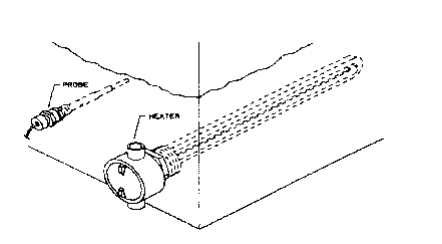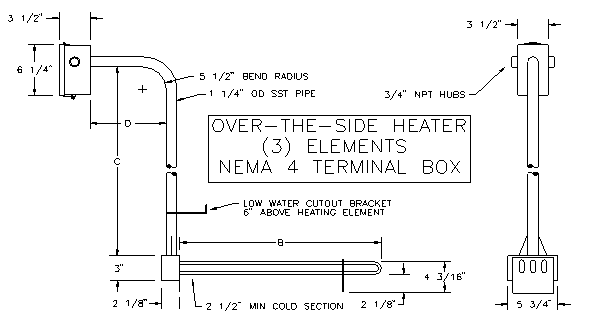Freeze Protection of Cooling Tower Basins
Abstract
Seasonally shutting down a cooling tower by draining the tower is often not possible for three reasons: (1) In large buildings, the central core must often be cooled, even in sub-freezing weather (2) in sections of the United States, the occasional warm winter day necessitates sporadic air conditioning operation and (3) year-round one or two shift industrial heating loads require cooling during day shifts but freeze protection at night. One can never use an anti-freeze solution in an open recirculating tower and it often is not practical to have the cold water sump drain into a heated portion of the building.
Electric immersion heaters are increasingly used to maintain cold water basin temperatures above freezing. Because the elements are fully immersed, they are 100% efficient, small, relatively inexpensive and easily controlled. A wide variety of heaters and control schemes will be discussed for the reader’s consideration.
Introduction
Electric immersion heaters in cold water basins are only meant to keep the water in the basin above freezing. These heaters will not protect the fill or the piping. Heating cable is usually wrapped around the piping and then insulated to freeze protect the piping. Most cooling tower manufacturers offer specific suggestions for operating the tower in freezing temperatures to protect the fill and other critical components.
The cold water basin is subjected to prolonged periods of stagnant water with treatment chemicals and contaminants. Selection of the sheath material is an important consideration because the elevated temperature of the element sheath is a catalyst for accelerated chemical corrosion. Both copper and 304 stainless steel sheathed compacted tubular heating elements at 50 watt/in2 have proved successful in small basins while large multi-cell towers sometimes use extremely long 304 stainless steel cartridge style heaters at 25 watts/in2. These longer cartridge heaters better distribute the heat in large basins. Electric heaters have many advantages over other heating methods such as steam, hot water boiler systems or a compressed air bubbling system.
There are two primary control issues, maintaining the water above freezing and providing low water cutoff protection in case the water level drops below the level of the heating elements. Basin freeze protection temperatures are often set at 45˚ F since the position of the sensor and the size of the
basin are variable and often result in significant temperature gradients across the basin. However, it is helpful to note that properly sized heaters can maintain basin temperatures well above 45˚ F as an aid in cold weather start-up of chillers. Consult the cooling tower manufacturer for suggestions.
Sizing
Basin heaters are often interlocked with the pump and should only operate when the tower is in a standby condition. Using the lowest expected ambient temperature, of which data can be found at here, the heat loss of an open top cold water basin can easily be calculated using the chart in Figure 1. We assume a 40˚ F set-point, steel basin, side area 40% the top and a 25% safety factor. Because most of the heat loss is from the surface of the water, below grade concrete sumps are de-rated 25%. The best design is to evenly distribute the heater(s) in the basins. However, one can compensate for uneven distribution by placing the sensor in the coldest area of the basin. The disadvantage of uneven placement is the higher energy consumption because of the larger temperature gradients.

Controls
A temperature regulating device and low liquid level protection are recommended for use with immersion heater(s) to control the heating process and safeguard the heater and tower from excessive temperatures. The system consists of electric immersion heater(s), a heater control panel with a temperature and liquid level sensor, and a power switching device (usually a magnetic contactor). Older style controls use a bulb and capillary thermostat with a separate float switch. Modern designs are solid state, some with a single probe for both low water protection and temperature sensing.
Both the heater(s) and control panel should have a liquid-proof and corrosion resistant enclosure suitable for outdoor/moist locations. The control panel may control more than one heater, up to its nameplate voltage, phase, and KW rating. Various options are available for control panels such as fusing, circuit breakers, door disconnect switch or GFI protection. UL and/or CSA listing may be required by local codes.
Heaters
Typically electric immersion heaters have 2˝ or 2 ½˝ NPT fittings for mounting through the wall of the cold water basin (Figure 2).

Mounting position is often determined by the cooling tower manufacturer with punched holes or half couplings already located in the basin wall. Place the heating elements horizontally and low in the basin but above any anticipated sludge level. Generally the minimum water level should be 2˝ above the heater elements and the heater a minimum 2˝ from the basin floor and wall(s).
If the wall is galvanized steel, a zinc scru-tite hub can be used to mount though the thin basin wall. If the basin is stainless steel, a stainless steel hub or flange assembly should be used to avoid a galvanic reaction between the stainless steel wall and the zinc scru-tite hub, (figure 3). Pipe thread heaters are installed by applying Teflon tape or pipe dope to the threads and tightening into the appropriate threaded nozzle or hub. Avoid over-tightening and retighten as required if a leak develops. Element bundles must be adequately supported; typically supports should be provided every 24˝ starting at 36˝ from the heater fittings.

Concrete basins are typically below grade and have multiple cells that drain into one concrete sump. Mounting heaters through a below grade concrete wall is problematic and an over-the-side
style heater is often used (Figure 4). The critical dimension on the over-the-side heaters is the riser height. Note the unit mounts on sludge legs that sit on the basin floor and an arm extends from the riser to position the terminal box outside the cooling tower water flow. The terminal box should be a NEMA 4X style because the life expectancy of a painted steel enclosure is fairly short in this environment.
If all the cooling tower cells drain into a common sump, then a single control can be used for freeze and low water protection. However, if the basins are separate, a control for each basin is required.

The size and type of incoming field wiring will depend upon the heater terminal box temperature, heater current draw per conductor, number of conductors per conduit, and wire insulation rating. Refer to the National Electrical Code Table 310-16 or C.E.C., tables 2 and 5C. Confirm all unused conduit holes in the heater terminal box are sealed with plugs suitable for the heater environment. Replace any plastic shipping plugs if an opening is not used. Attach a ground conductor to the stud located in the heater terminal box or by other appropriate means per NEC Article 250. A minimum of an annual inspection to re-tighten electrical connections to check the terminal enclosure and conduit connections for evidence of water leaks or moisture collection is advisable. Moisture in the terminal enclosure is one of the main causes of heater failure followed by operating in air and excessive build-up on the elements. Usually a performance check of the control system is done in early fall to allow repairs in a comfortable, non-critical environment.
Recent Developments
Fiberglass basins and building management systems have put additional requirements on the basin heater(s) and control scheme. Some heaters now incorporate a thermal fuse as an additional level of protection against overheating the basin wall. Controls sometime include GFI protection, a remote signal for low water indication and adjustable 0-100˚ F basin temperature set point.
Mark Cornwell is a Senior Sales Engineer at Indeeco, a manufacturer of electric heaters and controls located in St. Louis, MO.